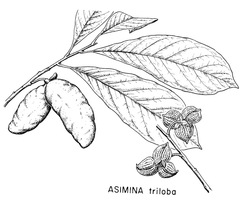 | Back to e-WV
| Back to e-WV
 The West Virginia Encyclopedia
The West Virginia Encyclopedia
 | Back to e-WV
| Back to e-WV
 The West Virginia Encyclopedia
The West Virginia Encyclopedia

The pawpaw, North America’s largest native edible fruit, is present throughout West Virginia. The only temperate member of the Annonaceae family, the pawpaw is a rich, nutritious fruit with a custard-like texture and sweet taste. The oval or kidney-shaped fruits vary from the size of a plum to that of a large potato. The skin is light green and the creamy flesh is yellow. Each fruit contains several large, dark brown seeds.
Pawpaw trees prefer slightly acidic, well-drained soil, and often are found along the banks of creeks and rivers. The leaves are about 12 inches long, glossy, distinctly veined, and droopy. Pawpaws tend to be small, understory trees, usually not more than 30 feet high. In spring, before the leaves appear, pawpaw trees produce bell-like blossoms, dark burgundy in color. The fruit ripens in early autumn and is ready to eat when fragrant and slightly soft.
Early European explorers in America recorded that the pawpaw was highly regarded by Native Americans, who ate the fruit and used the tree’s bark for making baskets. Consumed fresh in season, pawpaws later found a place in the folk diet of rural West Virginians. Pawpaws are still known primarily as a wild food, although a few growers are now cultivating them.
Written by Colleen Anderson
Reich, Lee. Uncommon Fruits Worthy of Attention. Reading, MA: Addison-Wesley, 1991.
Peterson, R. N. Genetic Resources of Temperate Fruit and Nut Crops. Acta Horticulturae, (Feb. 1991).